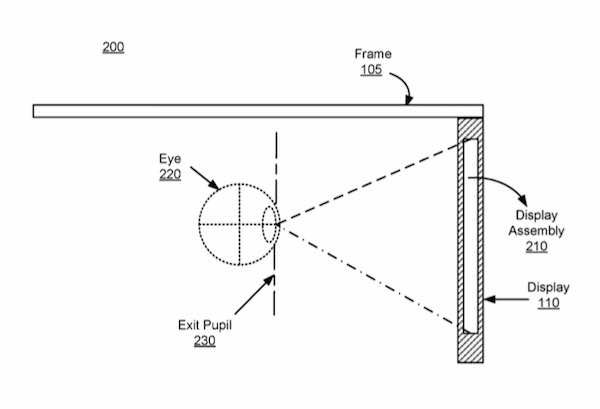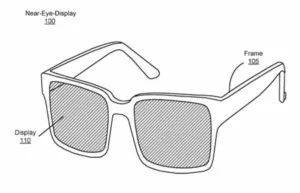Oculus is best known for the Oculus Rift headset that catapulted Facebook to the forefront of virtual reality. In recent months, Facebook management has made several statements indicating interest in AR in addition to the Oculus VR approach. While this was seen as a general idea that Facebook is also interested in AR and not just VR, it seems that these plans are much further along than some may have thought. Oculus applied for a patent “Waveguide display with two-dimensional scanner” (US 2017/0235143 A1) that describes AR glasses based on a scanning display element.
Oculus AR Glasses according to patent application
The provided images are of course schematic drawings but show clearly that the goal of the development are a set of glasses that cannot be distinguished from a standard pair of glasses. There is no added display element to the frame and all the electronics fits beautifully inside of the frame. The key to the technology behind these glasses is the use of scanning elements that use waveguides to bring the image to the eye.
 Oculus AR glasses display schematics
Oculus AR glasses display schematics
The patent application is not very forthcoming on how the firm wants to realize this feat other than through the use of 2D scanning display elements and waveguides. They also make clear that there is more than one scanning element and that the image is capable of creating a color image. Other than that they outline that the use of scanning elements in this type of application is limited by the achievable resolution. Oculus is using at least two scanning elements that seem to be embedded with the lens / waveguide. In other images it seems that it is attached to the back of the waveguide, a more likely scenario for the first implementation.
The display assembly would contain a variety of optical as well as electronic elements capable of creating an image for the eye. On the other hand, AR glasses require a transparency that can only be achieved if the display assembly is really small and the waveguides do not interfere with transparency of the glasses when there is no image displayed. This would be, of course, a very important requirement.
Analyst Comment
As is typical with this type of patent applications, there is more left to the imagination of the reader than is actually described on how they can achieve this in the first place. The really interesting part is, of course, the implementation, something that has created more compromises of image quality and physical size than the manufacturers would have liked. Nevertheless, what it does show is that Facebook is pushing Oculus strongly into the direction of AR instead of just doing VR. (NH)

